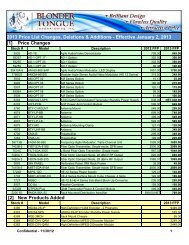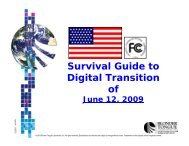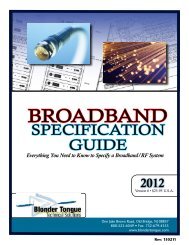Functional Block Diagram - Blonder Tongue Laboratories Inc.
Functional Block Diagram - Blonder Tongue Laboratories Inc.
Functional Block Diagram - Blonder Tongue Laboratories Inc.
You also want an ePaper? Increase the reach of your titles
YUMPU automatically turns print PDFs into web optimized ePapers that Google loves.
Broadband Specification Guide<br />
CATV Terms & Definitions<br />
Single-cable Design<br />
A technique for designing CATV systems that utilizes a single type of<br />
amplifier with identical transmission levels throughout the system. It<br />
may, or may not, actually require some placement of paralleling cables in<br />
portions of the system.<br />
Single-mode Fiber<br />
An optical waveguide through which only one mode will propagate.<br />
Single-mode waveguide is produced by reducing the diameter of the<br />
core of the waveguide to 2 to 10 microns. The diameter of the core<br />
is dependent on the difference in the refractive index of the core and<br />
cladding. As the difference in the refractive index of the core and cladding<br />
decreases, the diameter of the core increases. Theoretically, the core<br />
could be infinitely large as the difference in index become infinitely<br />
small. Single-mode operation is desirable because all modes except the<br />
lowest and simplest mode are excluded. This reduces time distortion of<br />
signals propagating in unwanted modes, retains phase relationships, and<br />
reduces dispersion to the lowest possible value.<br />
Slope<br />
Difference in attenuation between specified low and high frequencies.<br />
SLM<br />
Signal Level Meter. Test equipment used to measure RF signal strengths<br />
in CATV/MATV systems. Also referred to as FSM.<br />
SNR<br />
Acronym for signal-to-noise ratio.<br />
Source<br />
A device that, when properly driven (with electrical energy), will produce<br />
information-carrying optical signals.<br />
Sparklies<br />
Black or white dots or streaks that may appear in a satellite program’s<br />
picture. This condition is caused by an insufficient carrier-to-noise ratio.<br />
Spectrum<br />
A range of frequencies within which waves have common characteristics.<br />
For example, audio spectrum, radio spectrum, etc. Radio spectrum is<br />
generally accepted to include the range between 8 KHz and 300 GHz.<br />
Splice<br />
A permanent connection of two optical fibers.<br />
Splitter<br />
A network or device that divides its input energy equally between two<br />
outputs. It is possible to cascade (serially connect) splitters to provide<br />
more than two outputs, but usually the input energy is not then equally<br />
divided across those outputs if the outputs are not multiples of two.<br />
Star Coupler<br />
A passive device in which power from one or several input waveguides<br />
is distributed amongst a larger number of output optical waveguides.<br />
Step-index Fiber<br />
A type of fiber which has an abrupt change in index of refraction at the<br />
core/cladding interface. Generally such fibers have larger cores, higher<br />
losses, and lower bandwidths than graded-index types.<br />
Step-index Profile<br />
A refractive index profile characterized by a uniform refractive index<br />
within the core and a sharp decrease in refractive index at the corecladding<br />
interface.<br />
Strip Amplifier<br />
Slang expression for a channelized high-output AGC’d amplifier used in<br />
processing VHF or UHF channels in a headend.<br />
Sub-Band<br />
The radio spectrum between 5 and 40 MHz.<br />
Sub-Split<br />
Two-way cable communication frequency plan. Consists of an incoming<br />
frequency range of 5-40 MHz and an out-going of 50-450 MHz.<br />
Subscriber Converter<br />
See Converter, subscriber.<br />
Subscriber’s Loop<br />
Circuit between a local office and a subscriber's telephone set.<br />
Super-Band<br />
The radio spectrum between 216 and approximately 400 MHz.<br />
Super-Trunk<br />
A sub-system cable transmission link for transporting television signals<br />
between two discrete locations.<br />
Sync Pulse<br />
Information included in a composite video signal to synchronize the<br />
television receiver's picture tube electron beam with the electron beam<br />
in the television camera which originated the video signal, or with any<br />
other source of a video signal.<br />
Tap, Subscriber<br />
A device that diverts a predetermined amount of its input energy to one<br />
or more tap outputs for the purpose of feeding energy into subscriber<br />
service drop cables. The remaining balance of the input energy is<br />
presented to a tap output port for propagation farther out into the system.<br />
Tap, Optical<br />
A device for extracting a portion of the optical signal from a fiber.<br />
Tapoff<br />
Device to provide a small amount of signal from a distribution line to feed<br />
a TV set. Provides an asymmetrical signal split.<br />
TASO<br />
Television Allocation Study Organization, Industry group that advised the<br />
Federal Communications Commission on TV matters.<br />
93
















